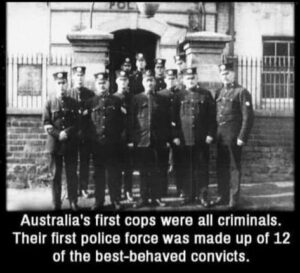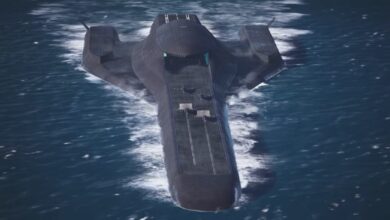Australias First Cops Were All Criminals
Australia’s First Cops Were All Criminals & Convicts
Are you ready for a trip back in time? Australia’s law enforcement history holds an intriguing fact: the country’s first police were all convicts. This post will reveal how the colony leveraged this unlikely group to maintain order, setting a unique precedent in criminal justice.
So let’s dive into this fascinating chapter of Australian history.
The Origins of Law Enforcement in Australia
Convicts were brought to Australia as a form of punishment, leading to the need for law enforcement in the newly established colonies.
Convicts in Australia
In the late 18th century, Australia acted as a dumping ground for British convicts. The petty criminals filled the new colony, with many serving their sentences under brutal conditions.
Governor Arthur Phillip established the Night Watch in 1789, forming it entirely of convict volunteers. This group of twelve selected for good behavior became Australia’s first civilian police force.
The majority had been transported for minor infractions like theft or forgery; serious crimes weren’t punishable by deportation until the 1830’s. Therefore, despite having criminal records themselves, these law enforcers were often dealing with offenses far graver than their own past misdemeanors.
Despite initial skepticism and unease from the community, these unusual officers managed to set down roots that grew into today’s formalized police services across Australia.
Reasons for transportation
The transportation of convicts to Australia was a result of various factors. One reason was the overcrowded prisons in England, which led to the need for alternative solutions. Additionally, there was a belief that criminals could be rehabilitated through hard labor and isolation from society.
The British government also saw colonization as an opportunity to expand its empire and establish control over new territories. As a result, thousands of convicts were transported to Australia as punishment for their crimes, ultimately shaping the early history of law enforcement in the country.
The Night Watch
The Night Watch, established in 1789 by Governor Arthur Phillip, was Australia’s first civilian police force. Composed of the 12 most well-behaved convicts, it played a crucial role in maintaining law and order in the colony of New South Wales.
The members of the Night Watch were carefully chosen based on their good behavior during their time as convicts. Despite the fact that they were all criminals at one point, they were entrusted with keeping Sydney Town safe from crime and disorder.
This early form of law enforcement laid the foundation for a more formalized police force in Australia’s history.
Australia’s First Police Force
Governor Arthur Phillip formed Australia’s first police force, consisting of convicts and Royal Navy Marines.
Formation by Governor Arthur Phillip
Governor Arthur Phillip played a significant role in the formation of Australia’s first police force. In 1789, he established the Night Watch, which consisted of 12 convicts who were considered to be the most well-behaved in the colony.
These convicts were chosen based on their good behavior during their time in Sydney Town. Under Governor Phillip’s direction, this civilian police force took on the responsibility of maintaining law and order in the early settlement.
Composition of the police force
The police force in Australia was composed of 12 well-behaved convicts. They were chosen based on their good behavior during their time in the colony.
Role and responsibilities
The role and responsibilities of Australia’s first police force, known as the Night Watch, were crucial in maintaining law and order in the colony. They were responsible for:
- Patrolling the streets of Sydney Town to deter crime and maintain public safety.
- Enforcing regulations and curfews to ensure orderliness within the settlement.
- Preventing theft and vandalism by keeping a watchful eye on shops, homes, and public spaces.
- Apprehending criminals and bringing them to justice, either through punishment or rehabilitation.
- Resolving disputes between settlers through mediation and peaceful resolution strategies.
- Assisting other colonial officials, such as magistrates, in their work by providing necessary information or evidence for court cases.
Controversies and Challenges
The perception of convicts as law enforcement officers raised concerns about their trustworthiness and discipline, posing challenges for the fledgling police force. Read on to discover how they navigated these obstacles and transitioned to a professional police force in Australia.
Perception of convicts as law enforcement officers
Convicts serving as law enforcement officers in Australia were often viewed with skepticism by the public. Despite being chosen for their good behavior, some people still questioned whether these former criminals could be trusted to uphold the law.
Many doubted their ability to separate themselves from their criminal pasts and carry out their duties with integrity. However, it is important to note that these convicts-turned-police officers played a crucial role in maintaining order and security in the colony during its early years.
Issues with discipline and trustworthiness
The convicts chosen for Australia’s first police force faced significant challenges with discipline and trustworthiness. As former criminals, there were concerns about their ability to enforce the law effectively and impartially.
Many people doubted whether these convict-turned-police officers could be trusted to uphold justice and act in the best interest of the community. This skepticism stemmed from their criminal pasts and the lingering perception that they may still have sympathies or connections to criminal elements within society.
The transition to a professional police force would later address these issues by establishing stricter hiring standards and training programs, ensuring that those entrusted with enforcing the law were trustworthy individuals able to carry out their duties responsibly.
Transition to a professional police force
The transition to a professional police force in Australia took place over several decades as the need for more effective law enforcement became evident. Initially, the Night Watch, composed of convicts who were considered well-behaved, was responsible for maintaining order.
However, their lack of formal training and limited authority led to challenges in effectively carrying out their duties. As the colony grew and crime rates increased, there was a push for a more organized and professional approach to policing.
In response to these concerns, Governor Lachlan Macquarie established the Sydney Foot Police in 1810. This marked an important milestone in the development of a formal police force in Australia.
The Sydney Foot Police consisted of both free men and ex-convicts who were carefully selected based on their character and ability to maintain law and order.
With time, efforts were made to further professionalize the police force by implementing training programs and improving discipline standards. The Royal Navy Marines gradually handed over their responsibilities to this growing police force, solidifying its role as the primary law enforcement agency.
Legacy and Impact
The establishment of Australia’s first police force composed of convicts had a lasting legacy on the evolution of law enforcement in the country.
Evolution of law enforcement in Australia
- Australia’s first police force was established in 1789, marking the beginning of a significant evolution in law enforcement.
- The role of law enforcement expanded with the establishment of new settlements beyond Sydney, such as Toongabbie, Hawkesbury, and Parramatta.
- As the colony grew, so did the need for a more structured and professional police force to maintain order and protect settlers.
- In 1825, the Night Watch was replaced by the Sydney Foot Police, which introduced greater organization and improved policing strategies.
- The Sydney Foot Police consisted of both soldiers from the Royal Navy and civilian officers who were selected based on their character and conduct.
- Over time, this early form of law enforcement began to transition into a more formalized police force that reflected changing societal needs.
- The influence of colonial policing practices from countries like England also played a role in shaping law enforcement strategies in Australia.
- By the mid-19th century, there was a shift towards establishing uniformed police forces throughout the Australian colonies.
- This period saw advancements in criminal investigation techniques and improvements in public safety measures.
- The legacy of Australia’s first police force can be seen in modern-day policing practices that prioritize community engagement, crime prevention, and professional standards.
Influence on modern policing practices
Australia’s early convict police force, despite its controversial origins, had a lasting influence on modern policing practices in the country. The formation of this unconventional police force marked the beginning of organized law enforcement in Australia.
Its composition of reformed convicts demonstrated that individuals with criminal backgrounds could be rehabilitated and contribute to maintaining order within society. This idea challenged traditional perceptions and paved the way for inclusivity within law enforcement agencies today.
The establishment of a formal police force in Australia was an essential step toward developing professional policing practices. It introduced concepts such as discipline, trustworthiness, and accountability among officers, which are still fundamental values within modern police forces across the nation.
Furthermore, this early experience provided valuable lessons on managing crime rates, community safety, and prisoner rehabilitation – principles that continue to shape contemporary approaches to law enforcement.
The legacy of Australia’s first convict police force extends beyond just institutional impact; it has also influenced cultural depictions and historical narratives about Australian colonial history.
By showcasing how former criminals contributed to maintaining order during a challenging period of settlement, these stories challenge assumptions about crime and punishment while emphasizing redemption and second chances.
Cultural depictions and historical significance
Cultural depictions and historical significance of Australia’s first convict police force have left a lasting impact on the country. These early law enforcement officers, though criminals themselves, are often portrayed in popular culture as rugged heroes who helped maintain order in the colonial era.
Their unique background as convicts turned police officers highlights the complex nature of Australian history. Moreover, their establishment as the first formal police force paved the way for modern policing practices and shaped the evolution of law enforcement in Australia.
The legacy of these criminal cops continues to fascinate and provoke discussions about justice, rehabilitation, and redemption in Australian society.
Continued Corruption and Brutality
Throughout the 19th century, the Australian police developed a reputation for corruption and excessive force, particularly against minority groups.
Many officers were former convicts or ex-criminals. Bribery and extortion were rampant within police ranks. It was common for officers to receive kickbacks from pickpockets, brothels, and illegal gambling operations.
Police frequently used brutal tactics, especially against Aboriginal groups. The Native Police units deployed against Indigenous Australians in frontier areas were essentially paramilitary forces involved in ethnic cleansing.
Even into the 20th century, police corruption and connections to organized crime-plagued cities like Sydney and Melbourne. Reforms starting in the 1960’s began professionalizing law enforcement across Australia and rooting out misconduct. But the convict origins of the police left a lasting impact.
The Bushrangers – When Criminals Became Cops
The Australian Bushrangers exemplified the fluid boundaries between criminals and law enforcers in the 19th century. Bushrangers were bandits who raided frontier settlements and targeted police patrols. But some went on to become policemen themselves.
The exploits of bushrangers like Ned Kelly have become part of Australia’s folklore. But many started out as convicts before escaping to lead lives of banditry. When subsequently captured, a few former bushrangers were recruited by the authorities to hunt their outlaw comrades.
John Donohoe, known as “Bold Jack,” was transported to Australia for petty theft. He later escaped and formed a bushranging gang that robbed mail coaches. After his capture in 1830, Donohoe was enlisted as a tracker for a paramilitary police force to hunt bushrangers because of his expertise.
Other notorious bushrangers like Martin Cash and Dan Morgan went on to become policemen after serving prison sentences. The line between outlaw and lawman was often blurred.
The police’s use of reformed criminals highlighted the lack of personnel and expertise in the colonies. But it also reflected ambivalent attitudes toward the role of police in society. The fluidity between criminal and cop epitomized the lawlessness of the frontier.
Legacy of Police Culture
Some historians argue that the early recruitment of convicts and ex-criminals influenced police culture in Australia for generations.
Many officers continued to perceive themselves as enforcers rather than public servants. Brutality and lack of accountability became normalized. Racism and discrimination remained rampant until reforms in recent decades.
However, others argue that the corrupt behavior of early police had more to do with a lack of training and oversight than the criminal backgrounds of recruits. And that the pioneer origins of the force led to an independent, rough-and-tumble attitude that was not itself immoral.
Either way, the first Australian police emerged from the criminal class, shaping perceptions of law enforcement’s role in society for better and worse. The convict roots of the force reflected the penal character of the British settlement that became Australia.
Conclusion
In conclusion, Australia’s first police force may have been composed of convicts, but these individuals were chosen for their good behavior and trustworthiness. While controversial at the time, this unique composition had a lasting legacy on law enforcement in Australia and influenced modern policing practices.
Today, we can look back on this unconventional beginning as an important part of Australian history and the development of a robust criminal justice system. So, it was all about it.
FAQs
1. Were all the first cops in Australia criminals?
No, not all of the first cops in Australia were criminals. While it is true that some early police officers in Australia had criminal backgrounds, it is not accurate to say that all of them were criminals.
2. What led to the recruitment of former convicts as policemen in Australia?
During the early days of European settlement in Australia, there was a shortage of law enforcement personnel. As a result, some individuals with criminal pasts were offered an opportunity for redemption by becoming policemen. This practice was eventually phased out as more professional policing structures were established.
3. How did the transition occur from convict-run policing to professional law enforcement?
Over time, as Australian society developed and expanded, there was a shift towards establishing more structured and professional law enforcement agencies. The recruitment criteria changed, requiring candidates without criminal records and placing an emphasis on training and professionalism.
4. Did having former convicts as police officers impact law and order in early colonial Australia?
There are mixed opinions regarding the impact of having former convicts as police officers during the early colonial period in Australia.
Some argue that their understanding of criminal networks contributed positively to maintaining order, while others believe it resulted in corruption or favoritism within the system. It is important to note that this practice was discontinued as law enforcement agencies evolved over time.




This article appears to be centered on the earliest days of New South Wales and would not appear to coincide with the history of policing in All Australian States.
One has to bear in mind that each Australian State was created/proclaimed through the British Imperial system of the time wherein each colony had an initiating Constitution and the personnel that constituted each landing and creation of authority in each State from the very beginning relied on military law enforcement together with the creation of Justices of Peace from within the community who presumably were of good reputation. Later after the colonies had been established and as they developed the inclusion of convict leaders at various stages into positions of authority to keep the peace occurred generally under the watch of Justices or the military commanders of relevant locations. WA for instance was first policed by military, retiring military personnel and their families who had traveled to Australia with them. The formality of a “Police Force” in WA was created in 1853 where previous personnel which included Justices, military and trusted ex-convicts notwiithstanding a prior record from Britain that was forgiven and who had established a trusted and good reputation in the development of colony. So therein the question really is a varied history between Australia States and practices therein and not simply one to be assessed and quoted as ALL Australian Police and to include the same as occurring in all the States from the beginning. After landings at Botany Bay the content of ships particularly in States after New South Wales tended to have more free citizens migrating to settle at other chosen locations. The New South Wales Police Force lineage obviously was established with Military control at first and adapted at a later stage as to be officially declared a “Police Force” of he then serving personnel.
Hi Geoff, totally valid points. I shall ask our writers to review the article and have it updated. I agree with your comments to structure it better around each state in Australia to make it more accurate.